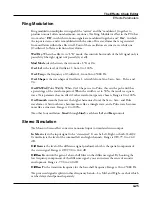
The Effects Chain Editor
Effects Parameters
4-21
Highpass
allows you to reduce the bass content of the distortion content in the smaller
distortion effects that don’t have true parametric EQ. Range is 16 to 25088 Hz.
Cab Preset
selects from eight cabinet simulations which have been created based on
measurements of real guitar amplifier cabinets. The presets are: Basic, Lead 12, 2x12, Open
12, Open 10, 4x12, Hot 2x12, and Hot 12.
Cab Bypass
switches on and off the cabinet-simulation part of the effect. When this is set to
“In”, the cabinet simulation is active; when it is “Out”, there is no cabinet action.
Cabinet HP
and Cabinet LP are highpass and lowpass filters to set the frequency response
limits of the cabinets. Range of both filters is 16 to 25088 Hz.
Polydistort
This is a more complex distortion effect that provides two, four, or six stages of distortion.
Curve n
controls the curvature of the individual distortion stages. 0% is no curvature (no
distortion at all). At 100%, the curve bends over smoothly and becomes perfectly flat right
before it goes into clipping. Maximum value is 127%.
LP n Freq
are shelving frequencies for one-pole lowpass filters on each of the distortion
stages. LP0 Freq handles the initial low pass prior to the first distortion stage. The other low
pass controls follow their respective distortion stages. Range is 16 to 25088 Hz.
Rotating Speakers
An effect that includes Rotating Speakers breaks the signal into two frequency bands,
“rotates” each band separately through a virtual speaker, and then combines the outputs with
a pair of virtual “microphones” whose angle relative to the speakers is adjustable. A number
of very sophisticated parameters have been included in the Rotating Speakers effect, to give
the effect a great degree of realism. Because of the complexity of the effects, you might want
to approach any parameters that seem a little obscure to you with caution.
Roto InOut
engages or bypasses the rotary speaker effect.
There are four virtual microphones, with two each on the woofer (LoMic A and LoMic B)
and on the tweeter (HiMic A and HiMic B). Each microphone has:
Pos
(position), the angle of the microphone from the front of the virtual speaker, from -180
to 180degrees;
Lvl
(level) from 0 to 100%; and Pan, the left/right panning of the microphone’s output,
from -100% (full left) to 100% (full right). Other parameters:
Lo Beam W
and Hi Beam W set the acoustic radiation patterns (“beam width”) of the two
drivers in the rotating speaker. If you imagine looking down on the rotating speaker, this is
the angle between the -6 dB levels of the beam. The range is from 45° to 360°. At 360°, the
driver is omnidirectional.
Содержание Flash Play PC4
Страница 1: ... It s the sound Part Number 910587 002 Rev B ...
Страница 9: ... ix MIDI Implementation A 1 Specifications B 1 Index I 1 ...
Страница 289: ... 8 40 ...
Страница 328: ... 10 7 ...
















































